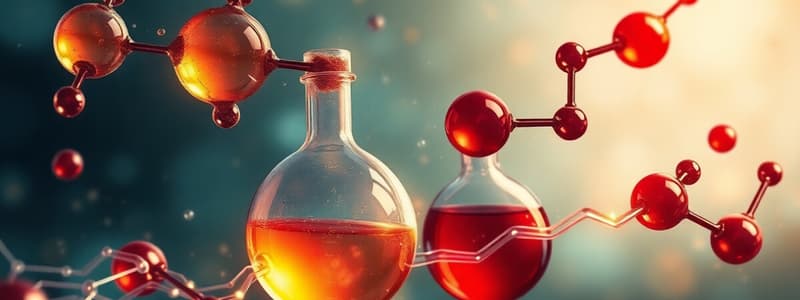Podcast
Questions and Answers
What is the product of reducing an aldehyde with sodium borohydride (NaBH4)?
What is the product of reducing an aldehyde with sodium borohydride (NaBH4)?
- Carboxylic acid
- Tertiary alcohol
- Primary alcohol (correct)
- Secondary alcohol
What type of alcohol is produced when a ketone is reduced?
What type of alcohol is produced when a ketone is reduced?
- Tertiary alcohol
- Primary alcohol
- Secondary alcohol (correct)
- No alcohol produced
In the Wolff–Kishner reduction, which compound is required for the reaction?
In the Wolff–Kishner reduction, which compound is required for the reaction?
- Lithium aluminum hydride
- Zinc
- Sodium borohydride
- Hydrazine (correct)
Which of the following is a characteristic of catalytic hydrogenation of carbonyl compounds?
Which of the following is a characteristic of catalytic hydrogenation of carbonyl compounds?
What reducing agent is commonly used to convert ketones into secondary alcohols?
What reducing agent is commonly used to convert ketones into secondary alcohols?
What is the primary product of the Cannizzaro reaction when two molecules of an aldehyde are reacted?
What is the primary product of the Cannizzaro reaction when two molecules of an aldehyde are reacted?
In the crossed Cannizzaro reaction, what happens to the formaldehyde when mixed with another aldehyde in the presence of conc. NaOH?
In the crossed Cannizzaro reaction, what happens to the formaldehyde when mixed with another aldehyde in the presence of conc. NaOH?
During the hemiacetal to acetal conversion, what occurs after the protonation of the hemiacetal?
During the hemiacetal to acetal conversion, what occurs after the protonation of the hemiacetal?
What is a characteristic of the aldol condensation reaction?
What is a characteristic of the aldol condensation reaction?
What is produced when two aldehydes are reacted in a crossed aldol condensation where one aldehyde does not have any α-hydrogens?
What is produced when two aldehydes are reacted in a crossed aldol condensation where one aldehyde does not have any α-hydrogens?
What role does the hydroxide base play in the Cannizzaro reaction?
What role does the hydroxide base play in the Cannizzaro reaction?
In the reaction mechanism of hemiacetal to acetal, what type of catalyst is required?
In the reaction mechanism of hemiacetal to acetal, what type of catalyst is required?
What is the result of deprotonation in the conversion of hemiacetals to acetals?
What is the result of deprotonation in the conversion of hemiacetals to acetals?
What type of alcohol is produced from the reduction of ketones?
What type of alcohol is produced from the reduction of ketones?
Which reagent is NOT commonly used for the reduction of aldehydes?
Which reagent is NOT commonly used for the reduction of aldehydes?
What is the product formed when cyanide is added to an aldehyde?
What is the product formed when cyanide is added to an aldehyde?
Which of the following describes the products formed from aldehydes reacting with alcohols?
Which of the following describes the products formed from aldehydes reacting with alcohols?
What is the role of acid in the reaction between ketones and alcohols?
What is the role of acid in the reaction between ketones and alcohols?
Which type of compound is formed when a carbonyl compound reacts with a derivative of ammonia?
Which type of compound is formed when a carbonyl compound reacts with a derivative of ammonia?
What is the mechanism involved in the reaction of carbonyl compounds with nucleophiles?
What is the mechanism involved in the reaction of carbonyl compounds with nucleophiles?
Which types of alcohols are produced from the reduction of aldehydes and ketones, respectively?
Which types of alcohols are produced from the reduction of aldehydes and ketones, respectively?
What type of reaction occurs when a carbonyl compound reacts with alcohol in the presence of an acid?
What type of reaction occurs when a carbonyl compound reacts with alcohol in the presence of an acid?
Flashcards
Clemmensen Reduction
Clemmensen Reduction
A chemical reaction that reduces a carbonyl group (C=O) in an aldehyde or ketone to a methylene group (CH2) using zinc amalgam (Zn/Hg) and hydrochloric acid (HCl).
Wolff-Kishner Reduction
Wolff-Kishner Reduction
A chemical reaction that converts a carbonyl group (C=O) in an aldehyde or ketone to a methylene group (CH2) using hydrazine (NH2NH2) and a strong base like potassium hydroxide (KOH).
Aldehyde
Aldehyde
An organic compound containing a carbonyl group (C=O) where the carbon atom is bonded to at least one hydrogen atom. It's usually represented by a general formula RCHO.
Ketone
Ketone
Signup and view all the flashcards
Reduce to 1ry alcohol
Reduce to 1ry alcohol
Signup and view all the flashcards
Hemiacetal
Hemiacetal
Signup and view all the flashcards
Acetal
Acetal
Signup and view all the flashcards
What conditions are required to convert a hemiacetal to an acetal?
What conditions are required to convert a hemiacetal to an acetal?
Signup and view all the flashcards
Cannizzaro Reaction
Cannizzaro Reaction
Signup and view all the flashcards
What is a crossed Cannizzaro reaction?
What is a crossed Cannizzaro reaction?
Signup and view all the flashcards
Aldol Condensation
Aldol Condensation
Signup and view all the flashcards
What's a cross aldol condensation?
What's a cross aldol condensation?
Signup and view all the flashcards
Grignard Reagent
Grignard Reagent
Signup and view all the flashcards
Reduction of Aldehydes
Reduction of Aldehydes
Signup and view all the flashcards
Reduction of Ketones
Reduction of Ketones
Signup and view all the flashcards
Nucleophilic Addition to Carbonyl
Nucleophilic Addition to Carbonyl
Signup and view all the flashcards
Cyanohydrin Formation
Cyanohydrin Formation
Signup and view all the flashcards
Hemiacetal Formation
Hemiacetal Formation
Signup and view all the flashcards
Hemiketal Formation
Hemiketal Formation
Signup and view all the flashcards
Acetal Formation
Acetal Formation
Signup and view all the flashcards
Ketal Formation
Ketal Formation
Signup and view all the flashcards
Derivatives of Ammonia
Derivatives of Ammonia
Signup and view all the flashcards
Reaction of Aldehydes and Ketones with Alcohols
Reaction of Aldehydes and Ketones with Alcohols
Signup and view all the flashcards
Study Notes
Preparation of Aldehydes and Ketones
- Alcohols can be oxidized to produce aldehydes and ketones.
- Primary alcohols are oxidized to aldehydes, which can then be further oxidized to carboxylic acids.
- Secondary alcohols are oxidized to ketones.
- Oxidizing agents include KMnO₄ or K₂Cr₂O₇.
Reactions of Aldehydes & Ketones
- Oxidation: Aldehydes are easily oxidized to carboxylic acids, while ketones are resistant to oxidation.
- Haloform: Reaction of methyl ketones and aldehydes with halogen in the presence of base forms haloform.
- Reduction: Carbonyl groups (C=O) in aldehydes and ketones can be converted to methylene groups (CH₂) through Clemmensen reduction (Zn/Hg/conc. HCl) or Wolff-Kishner reduction (heat with hydrazine and KOH in high-boiling alcohol).
- Nucleophilic Addition to Carbonyl: Addition of cyanide, derivatives of ammonia (e.g., cyanides, hydrazines, hydroxylamines, semicarbazides, and 2,4-dinitrophenylhydrazones), and alcohols to the carbonyl group.
- Cannizzaro Reaction: A redox reaction where two molecules of an aldehyde, without α-hydrogens, are reacted using a hydroxide base to produce an alcohol and a carboxylic acid.
- Aldol Condensation: Dimerization of aldehydes containing α-hydrogen atoms in alkaline media to form β-hydroxyaldehydes.
- Addition of Grignard Reagents: Grignard reagents (RMgX) react with aldehydes and ketones to form larger alcohols.
1- Oxidation
- Aldehydes easily oxidized to carboxylic acids.
- Ketones resistant to oxidation.
2- Haloform Reaction
- Reaction of methyl ketones and aldehydes with halogen in base to form haloform (after C-C cleavage).
- The aldehyde/ketone must have CH₃CO– group.
3- Reduction
- Conversion of carbonyl groups (C=O) to methylene groups (CH₂) using Clemmensen or Wolff-Kishner reduction.
- Zn/Hg/conc. HCl or NH₂NH₂, KOH used.
Reduction of Aldehydes and Ketones
-
Aldehydes: Reduced to primary alcohols
-
Ketones: Reduced to secondary alcohols
-
Reducing agents: LiAlH₄, NaBH₄, catalytic hydrogenation (Pd/H₂)
Nucleophilic Addition to Carbonyl
- Addition reactions to the carbonyl carbon of aldehydes and ketones, involving nucleophiles.
- Mechanism often involves protonation, nucleophilic attack, and deprotonation.
4i) Addition of Cyanide
- Reaction of aldehydes/ketones with cyanide (NaCN) followed by acid hydrolysis to yield cyanohydrins.
4ii) Addition of Derivatives of Ammonia
- Addition of hydrazine, hydroxylamine, semicarbazide, and 2,4-dinitrophenylhydrazine to carbonyls
4iii) Addition of Alcohols
- Reaction with alcohols in presence of acid to form hemiacetals and acetals.
- Reaction with alcohols in presence of base to form hemiacetals and ketals.
5- Cannizzaro Reaction
- A redox reaction of aldehydes without α-hydrogens in presence of base to yield alcohol and carboxylic acid.
6- Aldol Condensation
- Dimerization reaction of aldehydes containing α-hydrogens in alkaline conditions to produce β-hydroxyaldehydes.
7) Addition of Grignard reagents
- Grignard reagents (RMgX) react with aldehydes and ketones producing larger alcohols.
Amines
- An amine with one carbon attached to nitrogen is a primary amine.
- Two carbons attached to nitrogen is a secondary amine.
- Three carbons attached to nitrogen is a tertiary amine.
- Amines are more polar than alkanes but less polar than alcohols.
Preparation of Amines (by Alkylation of Ammonia and Reduction)
- Alkylation of ammonia with alkyl halides forms amines.
- Acid amides can be reduced to amines.
Inductive Effects and Basicity
- Electron-donating groups increase basicity of amines.
- Electron-withdrawing groups decrease basicity.
Studying That Suits You
Use AI to generate personalized quizzes and flashcards to suit your learning preferences.




